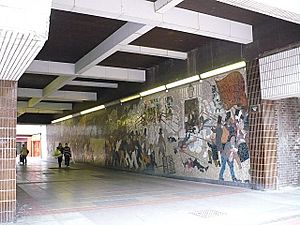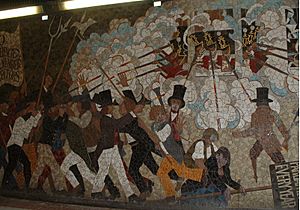Chartist Mural facts for kids
Quick facts for kids Chartist Mural |
|
|---|---|

The mural in 2008
|
|
| Artist | Kenneth Budd |
| Year | 1978 |
| Type | Mosaic |
| Dimensions | 360 cm × 3500 cm (144 in × 1344 in) |
| Condition | Destroyed, October 2013 |
| Location | Newport, Wales |
| 51°35′13″N 2°59′39″W / 51.58689°N 2.99419°W | |
The Chartist Mural was a large mosaic artwork in Newport, Wales. Artist Kenneth Budd created it in 1978. It was placed in an underground walkway for people to see.
This special mural was made to remember the Newport Rising of 1839. This was a big protest where about 22 people were sadly killed by soldiers. The mural was very long, about 35 meters (115 feet) and 4 meters (13 feet) high.
In 2013, the mural was destroyed. Many people were upset and protested against this decision. It was removed to make way for a new shopping area called Friars Walk.
Contents
What Was the Chartist Mural?
The Chartist Mural was made from 200,000 tiny pieces of tile and glass. Kenneth Budd designed it, and it was put up in 1978. It was located near John Frost Square, a place named after a leader of the Chartists.
The mural celebrated the Chartist movement and a protest called the Newport Uprising of 1839. During this event, John Frost led thousands of protesters to the Westgate Hotel. Soldiers fired on the crowd, and around 22 protesters died.
How the Mural Was Made
Kenneth Budd spent four months researching the Chartist rebellion. He worked with experts from the Newport Museum and Art Gallery. He then created the mural in hundreds of square panels in Kent, England. These panels were later put together in Newport.
The mural showed different parts of the Chartist story:
- The march of the Chartist protesters towards Newport.
- Their banners, which showed their demands for fairness and voting rights. These were called the Six Points of the People's Charter.
- Their gathering at the Westgate Hotel to share their demands.
- The sad moment when soldiers shot at the Chartists.
Why Was the Mural Destroyed?
In 2007, a part of the mural was taken away. Then, there were plans to remove the whole mural as part of a city centre building project. These plans were brought up again in 2012.
Some people suggested moving the mural or making a new version of it. They thought it could be put on ceramic tiles and shown at Newport Central Library. Kenneth Budd's son, Oliver, even offered to recreate a part of it. However, Newport City Council said the original mural was too hard to save or rebuild.
Efforts to Save the Mural
In May 2013, a group called the 20th Century Society asked Cadw (a Welsh heritage group) to protect the mural. They wanted it to be listed as an important historical artwork. But Cadw said no. They felt the building the mosaic was on was not special, and the underpass itself wasn't important. They also said the mural's location wasn't directly linked to the Chartist uprising.
Many people signed petitions and started online campaigns to stop the mural's destruction. A protest was planned. However, the council said they had to act quickly because of safety worries about the building next to the mural.
On October 3, 2013, contractors tore down the mural. The planned public protest still happened on October 5, with 200 people attending. People in Newport showed their anger in many ways, including making funny online videos.
Reactions to the Destruction
The destruction of the mural made many people angry, not just in Newport but across the country. Rob Williams from The Independent newspaper said it showed a lack of care for Welsh history. A spokesperson for Newport council said the mural "reminded us of Newport’s past, but we must now focus on Newport’s future."
The council promised to create a new way to remember the Chartist movement in a better spot. Paul Flynn MP said that trust between the people of Newport and the council needed to be rebuilt. The council's Chief Executive, Will Godfrey, apologized for not telling councillors about the demolition date beforehand. He said the process was not secret or unfair.
Michael Sheen's Letter
On October 18, 2013, actor Michael Sheen, who was born in Newport, wrote an open letter in the local newspaper, the South Wales Argus. He said it was "absurd as well as tragic" that something celebrating people who fought for fairness was destroyed without asking the public. He felt the council put profit first. In November, Sheen spoke at a conference about the Chartists. The council leader, Bob Bright, asked him to lead a group to find a replacement for the mural.
An editorial in the South Wales Argus on October 31 said the council lacked openness. It said the timing of the mural's destruction caused bad publicity everywhere. On November 26, the City Council said it "sincerely regretted" how the mural's removal was handled.
It was announced that a special group would be set up to create a new memorial. Newport City Council would give £50,000 for this project.
Rowan Williams' View
In March 2014, former Archbishop of Canterbury Dr Rowan Williams said the mural's destruction was "a sad blow for the city." Dr. Williams, who lived in Newport for almost 11 years, is part of the group looking for a new memorial. He said the destruction was a "great sadness" and that the Chartist legacy is a very important part of Newport's history.
- www.thepeoplescharter.co.uk


